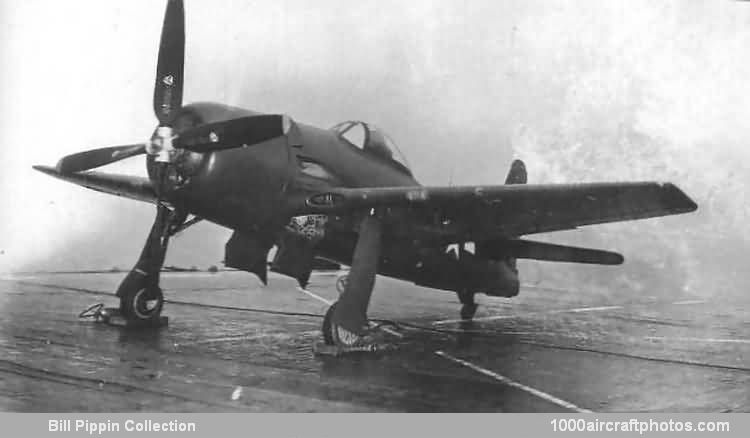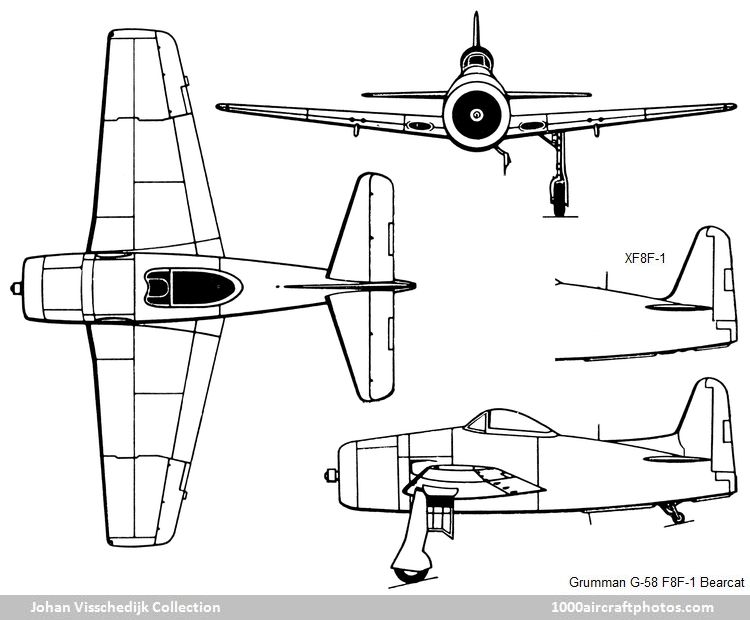Two prototypes of the Bearcat, designated XF8F-1, were ordered on November 27, 1943, and the first of these flew on August 21, 1944. Retaining the distinctive, portly lines that had characterized all earlier Grumman single-engined fighters, the XF8F-1 was appreciably smaller than the Hellcat and, was, in fact, what the Grumman design team considered to be the smallest fighter that could be designed around the Double Wasp engine and the specified fuel capacity, armament and armor protection. A weak point was built into each of the outer wing panels so that if the wings were overstressed in flight, the tips would break off, an explosive charge ensuring that both tips broke away. This feature was eventually eliminated.
The XF8F-1 was powered by a Pratt and Whitney R-2800-22W eighteen-cylinder air-cooled radial engine rated at 2,100 hp for take off and 1,600 hp at 16.000 ft (4,877 m). Internal fuel capacity was 150 gal (568 l), and at a gross weight of 8,788 lb (3,986 kg), the prototype attained maximum speeds of 393 mph (632 kmh) at sea level and 424 mph (682 kmh) at 17,300 ft (5,273 km), initial climb rate being 4,800 ft (1,463 m)/min.
Shortly after the test program began, contracts for 2,023 F8F-1 Bearcats were approved, deliveries commencing in February 1945. The F8F-1 differed from the XF8F-1 in few respects; a small dorsal fin was added, an R-2800-34W engine was installed, and internal fuel capacity was increased to 185 gal (700 l). Armament comprised four 0.50 in (12.7 mm) guns, plus two 1,000 lb (454 kg) bombs or four 5 in (127 mm) rockets, and 169 lb (77 kg) of armor was fitted.
The first USN squadrons to re-equip with the F8F-1 were working up on V-J Day, and were thus too late to see combat service, and the end of fighting resulted in drastic reductions in contracts for the Bearcat, the order placed with General Motors' Eastern Aircraft Division on February 5, 1945 for 1,876 Bearcats to be designated F3M-1 being cancelled completely.
Two hundred and eight Bearcats had been delivered by the end of 1945, and Grumman went on to produce a further 1,058 machines, including 100 examples of the purely post-war F8F-1B with four 0.787 in (20 mm) cannon, 36 F8F-1N night fighters, 293 F8F-2s with redesigned engine cowling and modified vertical tail surfaces, twelve F8F-2N night fighters, and sixty F8F-2P reconnaissance fighters. The Bearcat enjoyed an exceptional performance, and for a period held the world record for the fastest climb to 10,000 ft (3,048 m)."
The following data relate to the F8F-1.

